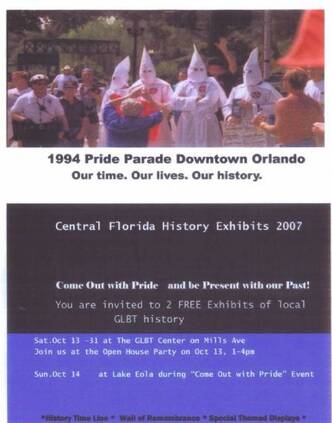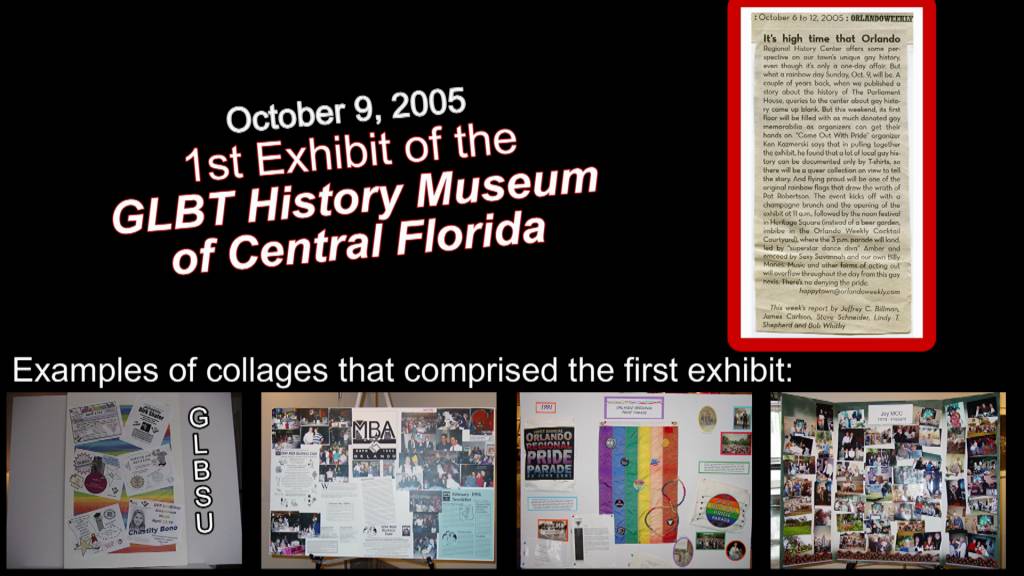|
How could they share the stories of activism and accomplishment of our community and the people who had led the way before them? What could they do to inspire young people to lead in the future? According to Debbie Simmons, one of the founders of the GLBT History Project, these were the thoughts that inspired the history displays at Orlando’s first Come Out with Pride on October 11, 2005 – National Coming Out Day
|
I thought it was so critical that we maintain the history [of our civil rights movement]…not only to give recognition to those people who did that work and put their lives on the line but for other movements that are obviously going to be necessary.
-Debbie Simmons, co-founder
The Metropolitan Business Association (MBA), UCF’s Gay Lesbian Bisexual Student Union (GLBSU) and the Orange County Regional History Center partnered together to organize the event. Ken Kazmerski, then the faculty advisor for the GLBSU, remembers that they had very little time and no formal resources for creating exhibits.
We only had 6 or 7 weeks to do this in. We met – we didn’t have anything, we didn’t have an office, a telephone or anything!
-Ken Kazmerski, co-founder
He asked the UCF students to bring pictures to create collages, Debbie did the same for the MBA, as did Pride Parade organizers Mary Brooks and Phyllis Murphy and the pastor of Joy Metropolitan Church. The stories their displays told captured participants’ interest and convinced the creators they needed to begin collecting our community’s history.
Creating a Museum: Preserving our Past to Inspire Future Activists

From those displays, the LGBTQ History Museum of Central Florida was born. The following year, 2006, the group had time to organize, plan, collect photos and information, and create exhibits. When Come out with Pride moved to Lake Eola Park in 2007, the History Project created a Wall of Remembrance, honoring the local activists who were no longer living, and a timeline of the community’s history.
Simmons remembers watching people as they visited the exhibits. She saw that some had no idea about the movement in Central Florida. Others were touched because they remembered those who had passed away. As she watched young people talking about their history, she kept thinking about how scared she had been to march in 1991 in Orlando’s first Pride Parade and knew she wanted to inspire them to feel confident by seeing how earlier generations had been activists.
Simmons remembers watching people as they visited the exhibits. She saw that some had no idea about the movement in Central Florida. Others were touched because they remembered those who had passed away. As she watched young people talking about their history, she kept thinking about how scared she had been to march in 1991 in Orlando’s first Pride Parade and knew she wanted to inspire them to feel confident by seeing how earlier generations had been activists.
This is to encourage and to inspire future leaders because they need us and we need them.
-Debbie Simmons, co-founder
Over the next ten years, the LGBTQ History Museum collected and exhibited our history. We set up a digital archive where people could contribute their photos, collected the papers of local LGBT organizations, and created mobile exhibits. Our goal was to build “a better future by understanding our past.”
In 2016, eleven years after displaying its “collages” at the first Come Out With Pride celebration, the museum partnered again with the Orange County Regional History Center to exhibit the history of our movement in Central Florida. By then, the museum had grown significantly. The GLBT History Project had incorporated as a 501c3 organization and changed its name to the GLBT History Museum of Central Florida. UCF student interns were working regularly in our collections. We had exhibited LGBTQ history in local businesses, art venues, and government spaces.
In 2016, eleven years after displaying its “collages” at the first Come Out With Pride celebration, the museum partnered again with the Orange County Regional History Center to exhibit the history of our movement in Central Florida. By then, the museum had grown significantly. The GLBT History Project had incorporated as a 501c3 organization and changed its name to the GLBT History Museum of Central Florida. UCF student interns were working regularly in our collections. We had exhibited LGBTQ history in local businesses, art venues, and government spaces.
|
Working with the History Center’s staff, the museum developed an exhibit - Pride, Prejudice, and Protest - that told the community’s story and was set to open in October to coincide with Come Out With Pride. Then, on June 12, 2016, the Pulse massacre happened. The curators decided they had to change the exhibit to acknowledge the event. For the museum, 2016 represented a turning point. On the one hand, LGBTQ history became a more visible part of Central Florida’s history, as Pamela Schwartz, curator at the Orange County Regional History Center, noted. Joel Strack, then Vice President of the museum, commented on the importance for the LGBTQ community of having the exhibit on display for four months in a government building.
|
|
We knew we had to incorporate it [the Pulse massacre] into the story because it was huge for your community, it was huge for our greater community…. [We began] to see this exhibit as part of Central Florida’s history GLBT history is part of it – it’s not separate from it, it’s not this thing that happened on the sidelines or behind the curtains...this isn’t a separate story.
-Pamela Schwartz, Curator of Exhibits, Orange County Regional History Center
On the other hand, the violence of the act showed that in the course of an evening, so much can shift. It reminded us how quickly history can be eradicated. For Joel, an activist who had fought to make sure young people would have a safer space than he had experienced, the pain of the Pulse massacre juxtaposed with the AIDS epidemic in the exhibit told our community’s story.
I’m in my late 50s and I was part of the AIDS epidemic... to see young people today having the same awful tragedy of death coming to them on their doorstep,...for young people that I thought, as a gay activist and pioneer, I had protected and made sure that they would have a safe life, to see them go through a similar tragedy was really intense. And to see it on display in the exhibit, where you have both the aids epidemic and the pulse massacre on two different walls, it tells the story of our community in a way that has never been told before, ever.... And so that was huge for me, that was really important.
- Joel Strack, former Vice President, LGBTQ History Museum of Central Florida
In the wake of hatred and violence, we turn to history for stability. The exhibition gave us something to hold on to; it showed the activism and the wealth of history in this community that young people need to learn. Pulse and the exhibit both reinforced the museum’s need to document, preserve and share our history.
MOVING INTO THE FUTURE
Recognizing that, in the wake of Pulse, Orlando is planning to host the nation’s largest museum documenting LGBTQ culture, the museum is continuing to explore and expand our role. We will continue to tell our community’s story in order to inspire future generations of activists. The museum also is working to make our collection more inclusive - to add more stories from lesbian, bisexual and transgender people, Spanish speakers, people of color, and those with disabilities. We hope to partner with another institution to provide a permanent home for our archival collections so that they will be accessible to researchers and the public. And we will continue to add to our virtual museum and look for spaces where our mobile exhibits can teach and share our history to honor those who have worked for the rights we have today and provide models for the future.

